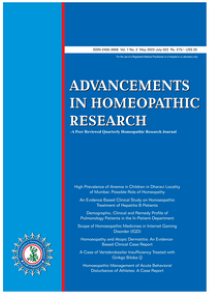A Comparative Study of Alcohol Percentage in Homeopathic Mother Tinctures by using GCHS & Conventional Method in Respect to Accuracy and Efficiency
DOI:
https://doi.org/10.48165/ahr.2024.9.3.1Keywords:
GCHS, homeopathic mother tincture, alcohol percentage in mother tinctureAbstract
Introduction: Technological advancement in homeopathic quality control helps for more accuracy in data & consumes less time. Technology progression has led to inclusion of modern instruments like UV spectroscopy, HPTLC, gas chromatography in homeopathic quality control. Assessment of alcohol percentage in homeopathic mother tincture is an essential quality parameter. However, estimation of alcohol percentage by using conventional method (CM) as described in Homeopathic Pharmacopoeia of India is time consuming at commercial level. Advanced technology of gas chromatography with head space (GCHS) is considered to minimise the process time, improve the efficiency, and provide more accuracy. However, there is no study to validate this statement in homeopathic industry. This study is aimed to find out the difference in both the methods.
References
1. Calixto JB. Efficacy, safety, quality control, marketing and regulatory guidelines for herbal medicines (phytotherapeutic agents). Braz. J. Med. Biol. Res. 2000 Feb; 33(2):179-89.
2. Ong, E. S. (2004). Extraction methods and chemical standardization of botanicals and herbal preparations. Journal of Chromatography B, 812(1- 2), 23-33.
3. Gupta, P., Sundaram, E., Sharma, M., Prajapati, S., Arya, B., Khurana, A., & Manchanda, R. (2018). Pre-clinicalpharmacology: An important aspect in homeopathic research. Indian Journal of Research in Homeopathy, 12(3),164-179.
4. Banerjee D., Augmented textbook of Homeopathic Pharmacy, B. Jain Publishers, Delhi, 2006, 2nd Edition.
5. Homoeopathic Pharmacopoeia of India, Department of Ayurveda, Yoga & Naturopathy, Unani, Siddha and Homoeopathy, Ministry of Health and Family Welfare, Government of India.
6. Nicoletti, M. (2012). Phytochemical Techniques in Complex Botanicals. The XXI Century Analytical Challenge. Journal of Chromatography and Separation Techniques, 10, 001.
7. Ravisankar, P., Gowthami, S., & Rao, G. D. (2014). A review on analytical method development. Indian journal of research in pharmacy and biotechnology, 2(3), 1183.




